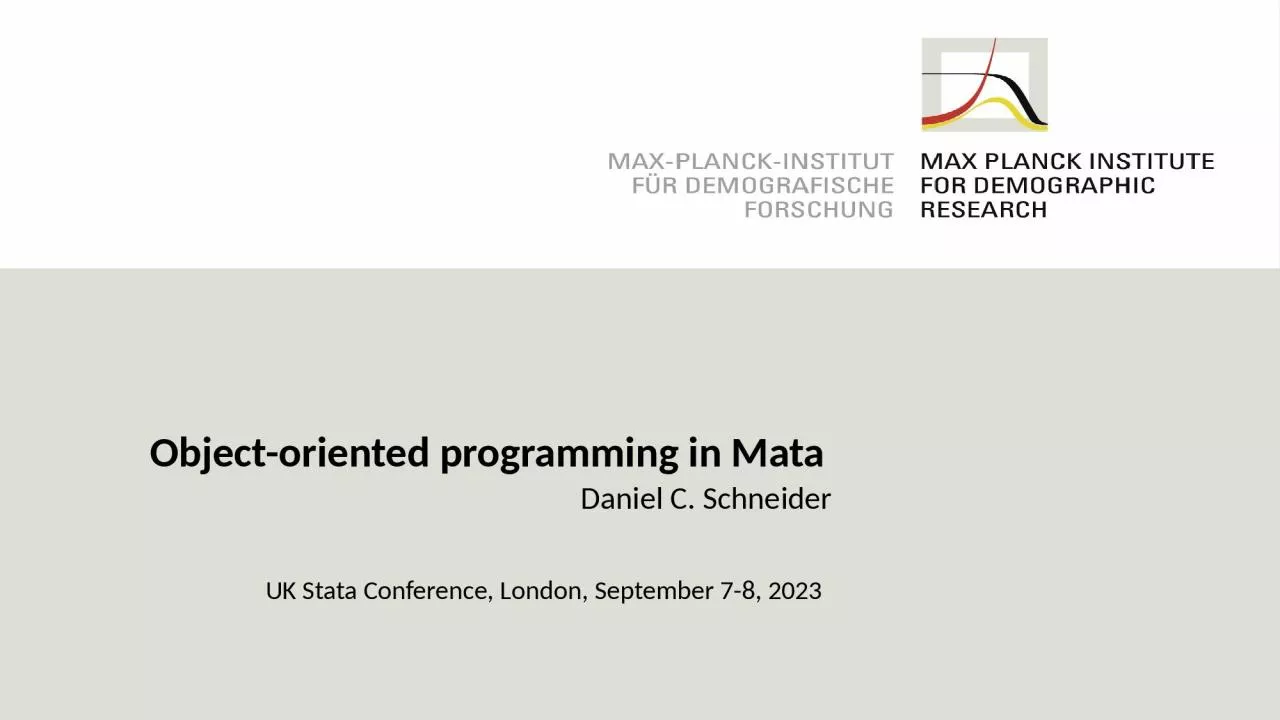

Daniel C Schneider UK Stata Conference London September 78 2023 Preliminary Remarks This presentation due to time constraints is not a proper introduction not rigorous ID: 1023062
Download Presentation The PPT/PDF document "Object-oriented programming in Mata" is the property of its rightful owner. Permission is granted to download and print the materials on this web site for personal, non-commercial use only, and to display it on your personal computer provided you do not modify the materials and that you retain all copyright notices contained in the materials. By downloading content from our website, you accept the terms of this agreement.
1. Object-oriented programming in MataDaniel C. SchneiderUK Stata Conference, London, September 7-8, 2023
2. Preliminary RemarksThis presentation, due to time constraints,is not a proper introduction, not rigorous.You just get a glimpse of OOP.Uses the -dtms- package as an illustrative example.Assumes some knowledge of Mata.Good resources on the topicOfficial Stata doc: help [M-2] classBill Gould's (2018) Mata bookObject-oriented programming in Mata
3. The dtms Package"dtms": Discrete-time multistate (models / estimation)Announcement on Stata Forum:https://www.statalist.org/forums/forum/general-stata-discussion/general/1690703-dtms-new-stata-command-for-discrete-time-multistate-model-estimationor google "dtms Stata"Contains location from which to -net install-.Will be moved to SSC.Analytical contributions in two soon-to-be-released working papersSchneider (2023)Schneider and Myrskylä (2023)Package doc "Methods and formulas" has sizable chunk of it.Object-oriented programming in Mata
4. The dtms Packagedtms estimation proceeds in sequential steps:(1) model setup(2) regression estimation (mlogit)(3) predict transition probabilities from (2)(4) calculate various results from (3)Calculated/defined objects of levels (0)-(3) can contain multiple elements of the next level => tree like structureObject-oriented programming in Mata
5. The dtms Package: The dtms TreeDiscrete-time multistate regression models in Stata
6. The dtms Package: The dtms TreeObject-oriented programming in Mata[...][...]
7. The dtms Package: Results ExampleObject-oriented programming in Matacname (composite name):uniquely identifies tree elements
8. Package Highlights / ContributionsDiscrete-time multistate regression models in Stata
9. Object-Oriented Programming IA class: an entity thathas members containing datacan do stuff: has functions (called methods)defined by a class definitioncode uses instances of a class (objects)OOP section I: Simple but interrelated classesGoal: a class that holds Stata e()-resultsOOP section II: Explain how the dtms tree worksObject-oriented programming in Mata
10. OOP I: Simple but Interrelated Classes: exStataMatrix
11. OOP I Side Note: Pointer VariablesPointersvariables that contain the memory address of another variablecan contain addresses of (loosely speaking) anything, where "anything" includes objectssee -help [M2] pointers-Object-oriented programming in Mata
12. OOP I Side Note: Pointer VariablesObject-oriented programming in Mata
13. OOP I: Simple but Interrelated Classes: exSimpleCollection
14. OOP I: Simple but Interrelated Classes: exEsavemany dtms tree elements have a similar class as a member
15. OOP II: Objects behind the dtms TreeObject-oriented programming in Mata Four things need to be solved:getting a pointer to a tree elementtree elements must knowabout upstream tree elementsiteration through all elements of a treeidiosyncrasies of tree elements (levels)must be accounted forSolution:1.-3. are based on only two class definitions: exTreeColl and exTreeElem4. makes use of OOP features: inheritance and polymorphism
16. OOP IIObject-oriented programming in Mata
17. OOP II: Objects behind the dtms TreeObject-oriented programming in Mata Step 1An exTreeElem object gets instantiated in memory.Its member function setup() must be called in order to pass information about its address to its member collection.Step 2That way, when the exTreeColl member uses its add() method to add an exTreeElem object, it can pass on that information into the exTreeElem object member.
18. OOP II: Objects behind the dtms Tree: Solutions to 1.-3.Object-oriented programming in Mata
19. OOP II: Objects behind the dtms Tree: Solution to 4.
20. OOP II: Objects behind the dtms TreeThis technique was used in dtms dirand coded explicitly in solution to 3.
21. Thank youschneider@demogr.mpg.deObject-oriented programming in Mata
22. ReferencesGould, William W. (2018). The Mata Book: A Book for Serious Programmers and Those Who Want to Be. Stata Press.Schneider, Daniel C. (2023). "Inference for Discrete-Time Multistate Models: Asymptotic Covariance Matrices, Partial Age Ranges, and Group Comparisons." [working title] MPDIR Working Paper, forthcoming.Schneider, Daniel C. and Mikko Myrskylä (2023). Extending Discrete-Time Multistate Models Using Markov Chains with Rewards: New Outcome Measures and Inference Results. [working title] MPDIR Working Paper, forthcoming.Object-oriented programming in Mata
23. The dtms Package: The dtms TreeDiscrete-time multistate regression models in Stata
24. The dtms Package: Project SizeLines of code, counting blank lines, roughly:Stata: 5,000test script: 6,000auxiliary: 3,000Mata: 11,000, makes heavy use of OOPSource code not (yet) onlinemay be made available in the futureObject-oriented programming in Mata